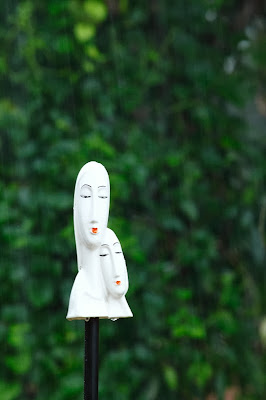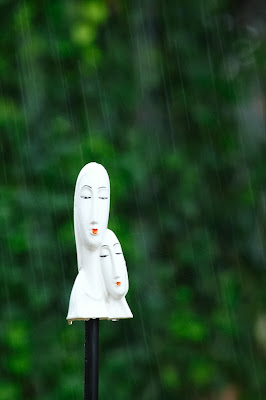 |
| Photo by: @lbyper |
We had published a couple of articles earlier in this blog regarding Rain Photography. They covered areas like general tips to keep your equipment safe during rains, what to photograph during rains, tips to enhance the effect of rain etc. you can read those here.
However one thing that we get asked a lot is regarding camera settings to capture rain drops in photos. This post explains how to capture pictures of raindrops; raindrops are moving subjects and could be photographed in two different ways. We could either capture the movement or we could completely freeze the motion. We will explain both techniques with the help of a series of pictures taken at different settings.
Speed is the key to Photographing Amazing Rain Photos
The key to capture rain in photography lies in the shutter speed used for the shot.
Blur the Rain
Slower shutter speeds capture the movement of the rain drops and they appear as a blur. Longer the shutter speed, greater the blur and vice versa. The key thing to remember is that using too slow a shutter speed will cause the raindrops to disappear.
Suggested Shooting Plan
- Set your camera to ISO 100
- Matrix/Evaluative Metering mode
- Shutter Priority / Time Value Shooting mode
- Choose your shutter speed. A shutter speed of 1/60 could be considered as a good starting point. Take a test shot, and review your shot in your camera’s LCD. To increase blur use longer shutter speeds and to decrease the amount of blur, use faster shutter speeds.
Freeze the Rain
To freeze the motion of rain drops and to give them more definition you need to use faster shutter speeds. However capturing raindrops completely frozen in photography is not as simple. To start with is the problem that rain drops are travelling at a very fast pace, to compound the problem, lighting conditions during rain are usually dim. To completely freeze the rain you will require a shutter speed much faster than 1/1000th of a second. This means that unless you are shooting in very bright conditions you’ll have to shoot at high ISO’s. An alternative method which is more effective especially in dull lighting conditions it is to use flash instead of shutter to ‘freeze’ raindrops. To do this one should preferably use an external flash set to a low power setting.
Suggested Shooting Plan
- Set your camera to ISO 800, (you should experiment shooting with various ISO settings and compare results; this will help you find out which is the highest ISO setting your camera is able to use without degrading image quality beyond acceptable standards. For my camera it is ISO 800, if yours has better low light performance by all means feel free to use higher ISO’s).
- Matrix/Evaluative Metering Mode
- Shutter Priority/Time Value Shooting Mode
Choose your shutter speed. The faster the shutter speed used lesser the blur in rain drops. We have given below some shots at various shutter speeds to give you a fair idea of the result shutter speed has on rain.
Notice the difference various shutter speeds has on rain drops
Shutter Speed 1/15
 |
| 1/15 |
Shutter Speed 1/20
 |
| 1/20 |
Shutter Speed 1/30
 |
| 1/30 |
Shutter Speed 1/60
 |
| 1/60 |
Shutter Speed 1/100
 |
| 1/100 |
Shutter Speed 1/125
 |
| 1/125 |
Shutter Speed 1/160
 |
| 1/160 |
Shutter Speed 1/200
 |
| 1/200 |
Shutter Speed 1/250
 |
| 1/250 |
Shutter Speed 1/500
 |
| 1/500 |
The lens had a maximum aperture of f/5.6 and 1/500 was the fastest speed I was able to achieve without further raising my ISO which was set to ISO 800. Now that we have seen the practical limitations of achieving high shutter speeds during rain and that even at 1/500 there is significant movement recorded in the rain drops, it is evident that to completely freeze rain we will require shutter speeds that are practically unattainable. so now we will discuss the alternative, instead of using shutter speed to freeze action we will now use flash.
Using Flash to Freeze Rain Drops
 |
| Photo By: Daniel Stark |
We all know that the flash delivers its light output in microseconds, it is often faster than 1/30,000 of a second. The lower the flash power set, the faster speed achieved.
The concept of using flash to freeze action is very simple, first kill the ambient light, this is easily done in dimly lit situations, now that flash is the only light illuminating your subject, the duration of the flash which is much shorter than any shutter speed your camera could come up with now becomes the effective shutter speed.
Suggested Shooting Plan
- Use an external flash unit, set it to a low power setting say 1/32 or 1/64, have some method of triggering it off camera and place it at the desired angle.
- Remember to wrap your flash in protective plastic bags to prevent it getting wet.
- Set your camera to Manual Mode
- Set shutter speed to the camera's sync speed.
- Take a test shot, use aperture and ISO to control exposure.
Post a Comment